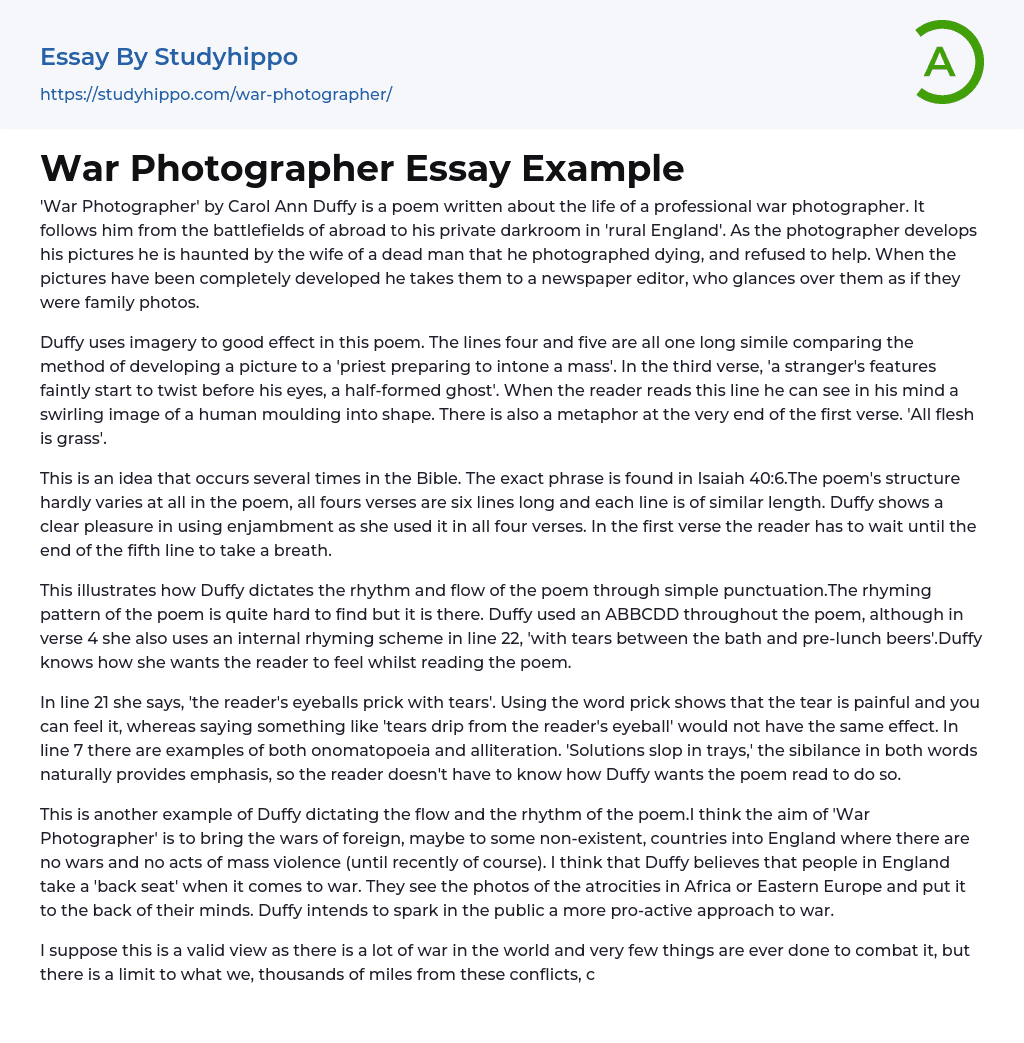'War Photographer' by Carol Ann Duffy is a poem written about the life of a professional war photographer. It follows him from the battlefields of abroad to his private darkroom in 'rural England'. As the photographer develops his pictures he is haunted by the wife of a dead man that he photographed dying, and refused to help. When the pictures have been completely developed he takes them to a newspaper editor, who glances over them as if they were family photos.
Duffy uses imagery to good effect in this poem. The lines four and five are all one long simile comparing the method of developing a picture to a 'priest preparing to intone a mass'. In the third verse, 'a stranger's features faintly start to twist before his eyes, a half-formed ghost
...'. When the reader reads this line he can see in his mind a swirling image of a human moulding into shape. There is also a metaphor at the very end of the first verse. 'All flesh is grass'.
This is an idea that occurs several times in the Bible. The exact phrase is found in Isaiah 40:6.The poem's structure hardly varies at all in the poem, all fours verses are six lines long and each line is of similar length. Duffy shows a clear pleasure in using enjambment as she used it in all four verses. In the first verse the reader has to wait until the end of the fifth line to take a breath.
This illustrates how Duffy dictates the rhythm and flow of the poem through simple punctuation.The rhyming pattern of the poem is quite hard to find but it is
there. Duffy used an ABBCDD throughout the poem, although in verse 4 she also uses an internal rhyming scheme in line 22, 'with tears between the bath and pre-lunch beers'.Duffy knows how she wants the reader to feel whilst reading the poem.
In line 21 she says, 'the reader's eyeballs prick with tears'. Using the word prick shows that the tear is painful and you can feel it, whereas saying something like 'tears drip from the reader's eyeball' would not have the same effect. In line 7 there are examples of both onomatopoeia and alliteration. 'Solutions slop in trays,' the sibilance in both words naturally provides emphasis, so the reader doesn't have to know how Duffy wants the poem read to do so.
This is another example of Duffy dictating the flow and the rhythm of the poem.I think the aim of 'War Photographer' is to bring the wars of foreign, maybe to some non-existent, countries into England where there are no wars and no acts of mass violence (until recently of course). I think that Duffy believes that people in England take a 'back seat' when it comes to war. They see the photos of the atrocities in Africa or Eastern Europe and put it to the back of their minds. Duffy intends to spark in the public a more pro-active approach to war.
I suppose this is a valid view as there is a lot of war in the world and very few things are ever done to combat it, but there is a limit to what we, thousands of miles from these conflicts, can do about itThe fact that the war photographer mentioned
in the poem is totally emotionally detached from his job shows that even the Brits involved in the war care very little as they are not fighting in it and they are not being attacked in it.I think this poem gets its point across very well, and although I'm not a huge fan of this sort of depressing genre of literature, it is quite a good poem. Duffy uses a mix of very long sentences and very short sentences very well and it is this stop-start flow that Duffy dictates with such ease.
- Book Summary essays
- Metaphor essays
- Reader essays
- Rhyme essays
- Literary devices essays
- Villain essays
- Books essays
- Genre essays
- Literary Criticism essays
- Writer essays
- Protagonist essays
- Simile essays
- Poem essays
- Book Report essays
- Book Review essays
- Greek Mythology essays
- Plot essays
- Tragic Hero essays
- Coming of Age essays
- Play essays
- Rhetoric essays
- Rhetorical Question essays
- Translation essays
- Understanding essays
- Reason essays
- Character essays
- Letter essays
- American Literature essays
- Literature Review essays
- Utopia essays
- Poetry Analysis essays
- Dante's Inferno essays
- Between The World and Me essays
- Incidents in The Life of a Slave Girl essays
- Flowers for Algernon essays
- Myth essays
- Everyday Use essays
- Boo Radley essays
- Genesis essays
- Richard iii essays
- Alice in Wonderland essays
- On the road essays
- Ozymandias essays
- The Nightingale essays
- Holden Caulfield essays
- Animal Farm essays
- 1984 essays
- A Hanging essays
- Shooting An Elephant essays
- A Tale Of Two Cities essays




